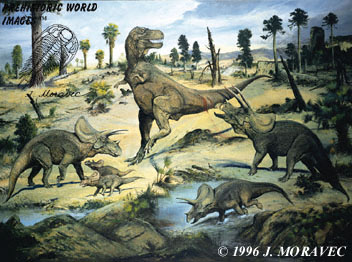|
|
|
TRICERATOPS
prorsus
TYRANNOSAURUS
rex |
|

|
|
Oil
painting |
|
|
TRICERATOPS
prorsus
Triceratops was the most numerous of the horned
cretaceous dinosaurs as well as the largest ceratopsian; it was one of the last to become extinct. Its name
means "three horned face". Triceratops was a herbivore and its largest predator was Tyrannosaurus rex. It
probably ate cycads and all other low-lying plants; it could chew them well
with its cheek teeth. These animals probably lived in vast herds and hatched
from eggs. They made up the bulk of the herbivore population just before the
end of the Cretaceous period.
Triceratops had a skull that reached up 6 ft (2m) in length with three protective horns and a great frill of bone that served for muscle attachment
to the neck as well as protection from predators. Triceratops had one short horn
above its beak and two long, double-recurved brow horns (up to 3 ft/90 cm
long). The horns provided it with a very dangerous weapon and may have also
been used in mating rivalry and rituals. Its head with large eyes was almost
one-third as long as its body (up to 10 ft/3 m long) and was the largest
ever possessed by a land animal. Its tough beak was toothless, but
Triceratops had many cheek teeth and powerful jaws. It walked on all four,
short and sturdy legs with hoof-like claws. Its body was bulky and it had a
short tail. It also had a thick bumpy hide, prints of which have survived,
to protect it against predator attacks, many of which could have come from
the fearsome T-rex. Triceratops skulls are very common occurrences in the fossil record,
in coastal lowland sediments, but skeletons are rare. Many specimens have
bones damaged in combats with predators. Triceratops remains were first
discovered in 1887 (Colorado, USA)..
Triceratopses
were continually harassed by the attacks of the vicious Tyrannosaurus
rex. Protecting the young was always a problem, and the T-rex ate any
of the animals that it could get. By sticking together and keeping
their horns in front of them, Triceratopses could
be a formidable opponent.
TIME
- 70 - 65MYA, Late Cretaceous period.
RANGE
- USA Montana, N. Dakota, S. Dakota,
Wyoming, Colorado. CANADA - Alberta.
SIZE
- Up to 30Ft (9m) long.
WEIGHT
- 2 US tons.
TYRANNOSAURUS rex
Tyrannosaurus rex, probably one
of the most famous cretaceous dinosaurs ever, was a member of the family Tyrannosauridae. It was a theropod, a saurischian
dinosaur, that belongs to the one of the largest terrestrial carnivores of
all time. This "tyrant lizard" is the best known of all dinosaurs. T-rex was
one of the most awesome creatures, that have walked on the earth. Tyrannosaurus rex was one of the largest meat-eating dinosaurs, but it
is still debated, whether it was an active hunter or a scavenger. It probably fed on decaying bodies of dead dinosaurs,
like most carnivores. T-rex probably lived in forests, in a humid,
semi-tropical environment. Tyrannosaurus was a bipedal, it walked on two muscular legs. Each foot had three
large toes, all with claws, and it also had a dewclaw. Its arms were small,
each with two fingers. Tyrannosaurus rex had very large head, a short neck and a slim tail;
its skull was up to 5 feet (1,5 m) long. Its eyes were faced forward, it
could focus them directly to the front. Its teeth in large jaws were sharp,
jagged and 6 inch (15 cm) long. It is known, on the base of fossilized
specimens, that Tyrannosaurus rex had "lightly pebbled skin", bumpy, like an
alligator. Its brain was comparable in size to those of modern reptiles.
The first complete T-rex skeleton was discovered in 1902, and many great examples have been unearthed over the last 15 years.
TIME
- 70 -65 MYA, Late
Cretaceous period.
RANGE
- USA: Colorado, Montana, N Dakota, New Mexico,
Wyoming.CANADA - Alberta,
Saskatchewan.
SIZE
- 15 ft(5m) tall and 36 ft (12m) long.
WEIGHT
- 6.5 US tons. |
|
* Also see:
Tyrannosaurus with
young, Tyrannosaurus
eating,
and Albertosaurus
with Corythosaurus.
|
|
|

